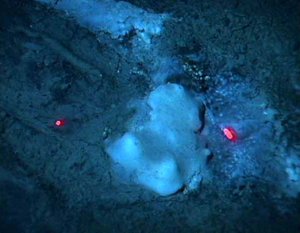Cold seep
|
|
A cold seep (sometimes called a cold vent) is an area of the ocean floor where hydrogen sulfide, methane and other hydrocarbon-rich fluid seepage occurs. Cold seeps are distinct from hydrothermal vents: the former's emissions are of the same temperature as the surrounding seawater, whereas the latter's emissions are super-heated. Cold seeps constitute a biome supporting several endemic species.
Entire communities of light independent organisms - known as extremophiles - develop in and around cold seeps, most relying on a symbiotic relationship with chemoautotrophic bacteria. These bacteria, both archaea and eubacteria, process sulfides and methane through chemosynthesis into chemical energy. Higher organisms, namely vesicomyid clams and vestimentiferan tubeworms use this energy to power their own life processes, and in exchange provide both safety and a reliable source of food for the bacteria. Other bacteria form mats, blanketing sizable areas in the process.

Unlike hydrothermal vents, which are volatile and ephemeral environments, cold seeps emit at a slow and dependable rate. Likely owing to the differing temperatures and stability, cold seep organisms are much longer-lived than those inhabiting hydrothermal vents. Indeed, recent research has revealed seep tubeworms to be the longest living noncolonial invertebrates known, with a minimum lifespan of between 170 and 250 years.
Cold seeps were first discovered in 1984 by Dr. Charles Paull in the Monterey Canyon, just off Monterey Bay, California, at a depth of 3,200 metres. Since then, seeps have been discovered in other parts of the world's oceans, including the Gulf of Mexico, the Sea of Japan, and in waters off the coast of Alaska. The deepest seep community known is distributed between the Kuril and Japan trenches and the Kashima seamount in the Sea of Japan, at a depth of 5,000 to 6,500 metres.
Cold seeps develop unique topography over time, where reactions between methane and seawater create carbonate rock formations and reefs. These reactions may also be dependent on bacterial activity.
External links
- Paul Yancy's vents and seeps page (http://people.whitman.edu/~yancey/califseeps.html)
- Monterey Bay Aquarium Research Institute's seeps page (http://www.mbari.org/benthic/coldseeps.htm)
- ScienceDaily News: Tubeworms in deep sea discovered to have record long life spans (http://www.sciencedaily.com/releases/2000/02/000203075002.htm)

